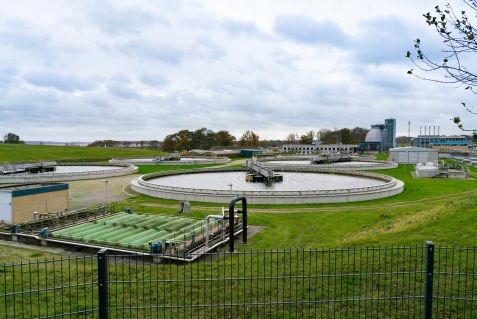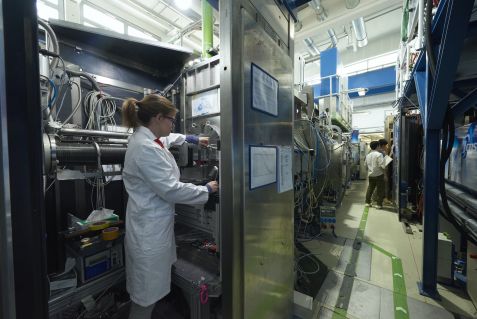MLZ is a cooperation between:
 > Technische Universität München
> Technische Universität München > Helmholtz-Zentrum Hereon
> Helmholtz-Zentrum Hereon
 > Forschungszentrum Jülich
> Forschungszentrum Jülich
MLZ is a member of:
 > LENS
> LENS > ERF-AISBL
> ERF-AISBL
MLZ on social media:

MLZ (eng)
Lichtenbergstr.1
85748 Garching
26.05.2021
Nanomaterial fights back against resistant bacteria

Water is treated in a wastewater treatment plant. A nanomaterial made of humic acid and titanium oxide could filter bacteria and antibiotic residues out of the water in the future. © Wunderstock/wuestenigel
Significant amounts of antibiotic residues and pathogens enter the environment via our wastewater. A German Italian team of researchers has now investigated a novel nanomaterial that has an antibacterial effect and can bind antibiotics at the Heinz Maier-Leibnitz Zentrum. Wastewater could thus be treated more effectively and safely.
Antibiotic resistance is one of the greatest global health challenges of our time. Wastewater treatment plants are a true breeding ground for antibiotic-resistant germs, as this is where pathogens and antibiotic residues come together. The resistant bacterial strains then re-enter the environment via the treated water and can spread further.
Scientists at the University of Naples Federico II have now developed a nanomaterial to combat this problem. Supported by instrument scientist Dr. Judith Houston from Forschungszentrum Jülich (and meanwhile at the European Spallation Neutron Source ESS in Sweden), they have analyzed it at the Heinz Maier-Leibnitz Zentrum. The material is a hybrid of humic acid and titanium dioxide (TiO2). Humic acids (HAs), which occur naturally in humus soils, have useful properties that can counteract water pollution: on the one hand, they have an antibacterial effect, and on the other hand, they can bind small molecules such as antibiotics.
Neutrons reveal the structure of the hybrid material
Dr. Giuseppe Vitiello of the University of Naples Federico II, the first author of the study explains, “The hybrid nanomaterial has strong destructive properties against many Gram-negative bacteria.” These include, for example, the pathogens E. coli, Salmonella or the causative agent of cholera. “In addition, the material has an exceptionally large surface area relative to its volume. As a result, it acts like a filter for widely used antibiotics, such as the broad-spectrum agents amoxicillin and tetracycline.”
To understand the functional properties of the humic acid/titanium oxide hybrid in more detail, the scientists used the KWS-2 small-angle neutron scattering facility at MLZ. “The use of neutrons was absolutely critical in helping us understand how the nanomaterial is constructed,” Vitiello said. “The measurements allow us to see the hierarchical arrangement of the nanostructures. The small TiO2 particles in it are randomly assembled with the HA to form porous nanoclusters that can eliminate antibiotics.”
Double the power against antibiotic resistance
The new hybrid material developed by the researchers could play an important role in the fight against antibiotic resistance. “Thanks to its dual function as antibacterial and antibiotic-binding substances, the nanomaterial could be used as an active phase in filters or membranes,” Vitiello explains. In this way, wastewater can be directly purified from chemicals and pathogens. This prevents the emergence of new resistances. “At the same time, our strategy supports the circular economy if we can recycle biowaste better in this way,” Vitiello adds. “Overall, we want to use it to improve the quality of life.”
Original publication
Giuseppe Vitiello, Virginia Venezia, Mariavittoria Verrillo, Assunta Nuzzo, Judith Houston, Stefano Cimino, Gerardino D’Errico, Antonio Aronne, Luigi Paduano, Alessandro Piccolo, Giuseppina Luciani. Hybrid humic acid/titanium dioxide nanomaterials as highly effective antimicrobial agents against gram(−) pathogens and antibiotic contaminants in wastewater. Environmental Research. 193 (2021). DOI: 10.1016/j.envres.2020.110562
MLZ is a cooperation between:
 > Technische Universität München
> Technische Universität München > Helmholtz-Zentrum Hereon
> Helmholtz-Zentrum Hereon
 > Forschungszentrum Jülich
> Forschungszentrum Jülich
MLZ is a member of:
 > LENS
> LENS > ERF-AISBL
> ERF-AISBL
MLZ on social media:



